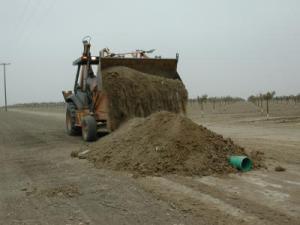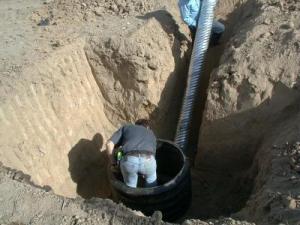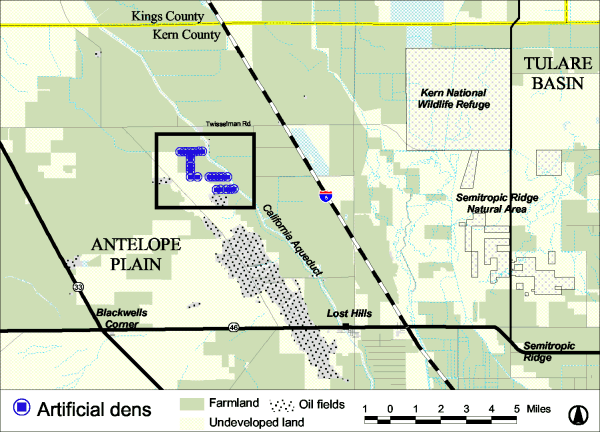Endangered Species Recovery Program | |
|
Home | News | Publications | Species profiles | Data and maps | About | Staff | Links | Department of Biological Sciences | CSU Stanislaus |
Paramount Farming Company, Inc., Safe Harbor Project
Introduction
Endangered San Joaquin kit foxes (Vulpes macrotis mutica) occur in natural communities adjacent to agricultural lands in the San Joaquin Valley of California. Investigations conducted by the California State University-Stanislaus, Endangered Species Recovery Program (ESRP) indicate that use of agricultural lands by kit foxes is limited, and therefore such lands may act as barriers to kit fox movements. Lack of escape cover and vulnerability to attack by larger predators is one reason that kit foxes may restrict use of agricultural lands.
In collaboration with Environmental Defense and Paramount Farming Company, ESRP installed artificial refugia (i.e., dens) on Paramount property in Kern County during November and December 2000. The purpose of these dens is to facilitate the safe movement of kit foxes between natural land parcels that border Paramount lands on the east and west The objective of this study is to determine whether kit foxes will use these artificial dens to traverse agricultural lands. Additional funding has been provided by the Nature Restoration Trust, a joint program of the National Fish and Wildlife Foundation and Pacific Gas and Electric Company.
Site Description
The study site encompasses approximately 1,668 ac of land in Kern County, California, owned by the Paramount Farming Company (Township 25 South; Range 20 East; sections 2, 3, 34, and 35). This land is in agricultural production; pistachios, almonds, and cotton are the primary crops. The site is situated between the California Aqueduct on the east and the Lost Hills oilfield on the west. Natural and semi-natural communities are present along the Aqueduct and in the oilfield, and primarily consist of saltbush scrub and grasslands dominated by non-native species. Kit foxes as well as coyotes and non-native red foxes are present in these communities.
Den Installation
Artificial dens were installed on the Paramount site on November 28 and 30, and December 11 of 2000. These included 21 surface or "escape" dens and 4 subterranean dens with chambers. Surface dens consisted of 3-m or 6-m lengths of 20-cm diameter PVC or metal pipe placed on the surface of the ground. These pipes were covered with soil, and one end was left uncovered on 11 dens while both ends were left open on 10 dens. For subterranean chambered dens, a 3-m length of PVC or metal pipe was placed in the ground leading downward to a 1-m diameter subterranean chamber. The entrances to all dens were uncapped on 14 February 2002.


Escape den and subterranean den installation
On 29 March 2002, all dens were examined using a burrow probe camera but no animals were found to be occupying the dens. All of the den entrances were reduced in size on 9 July 2002 by hammering 25-cm reinforcement bar (rebar) shafts into the ground 15-cm apart. This allows kit foxes to enter the dens, but excludes adult red foxes and coyotes from using the dens. At this time, one chambered den remains capped. Due to soil subsidence and roof collapse, this den may pose a risk to animal occupants.
Monitoring Methods
Track stations
Track stations have been constructed in front of each den entrance. These stations were created by smoothing the ground surface, and then sifting a 2-5 mm layer of fine, dry soil over an approximately 0.5-m2 area. The stations are being examined for tracks of kit foxes and other species. Track stations were first established at den entrances on 26 April 2002. The stations are checked once or twice a week, and any animal tracks present are identified.
Spotlight surveys
Spotlight surveys are being conducted on and in the vicinity of the Paramount site. These surveys target kit foxes, but sightings of prey species, red foxes, coyotes, and other species also are recorded. Two observers in a vehicle drive a route through the study site at 15-25 km/hr and each observer pans with a spotlight. Animals observed are identified to species (using binoculars if necessary), and the location of all observed animals is recorded. The spotlight route begins on the California Aqueduct, then moves out into the Paramount site near all the dens, and then onto the grasslands near the dens. Bureau of Land Management properties are adjacent to the Paramount site, and are spotlighted as well. At the end of the survey route, the Antelope Plains are spotlighted. These Plains are approximately 3.2 km west of the Paramount site, and contain the nearest stable population of the San Joaquin kit fox.
Kit fox activity so far
A kit fox was spotted near the Paramount site on 14 February, 22 November, and 4 December 2002. Kit foxes were also observed on the Antelope Plains during 10 of the spotlighting surveys (15 records of at least 5 foxes). Common wildlife species seen during the spotlight surveys on the Paramount site include coyotes, red foxes, burrowing owls, raccoons, barn owls, skunks, kangaroo rats, desert cottontails, black-tailed hares, deer mice, and cats.
On the 4th and 24th of December 2002, and the 3rd, 8th, and 14th of January 2003, sixteen box traps were set in the vicinity of the Paramount site. Traps were allowed to remain open overnight and then checked and recovered. One kit fox capture resulted on 14 January. It was an adult female, probably young of last year. She was radio-collared, weighed, and ear-tagged. Unfortunately, on 24 January, a mortality signal was detected on her radio-collar, and her body was recovered soon after. On 27 January a necropsy was conducted and it was determined that she was killed by a coyote.
On 26 July 2002 a canid scat was found and collected near den SE21. The scat was sent to the The National Museum of Natural History - Smithsonian Institution - Molecular Genetics Laboratory. The resulting genotype came back as "kit fox" - which shows that kit foxes are indeed visiting the dens.
